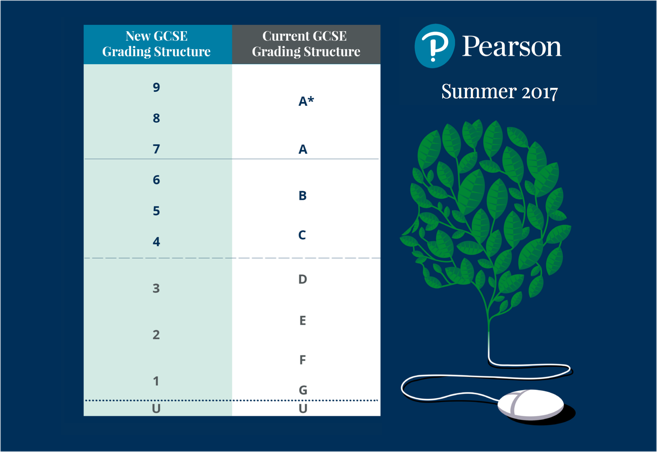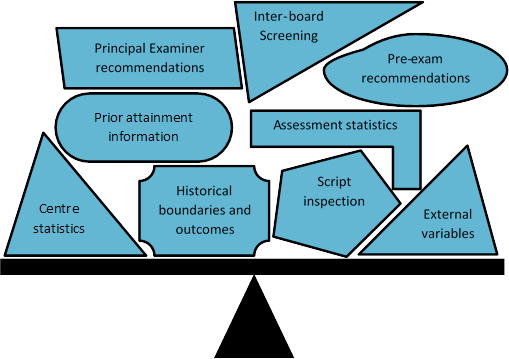Understanding marks and grades
Get an overview of how we mark assessments and consistently award grades that fairly reflect a learner's performance.
To ensure that our qualifications continue to receive recognition from employers and education providers, we have to demonstrate that learners of the same ability are awarded the same grade, regardless of when they completed their course. The information below explains how we do this.
Setting grade boundaries to fairly reflect performance
We set new grade boundaries each time a new exam or assessment is completed. They indicate the minimum number of marks students need to achieve to get a particular grade.
The GCSE (9-1) qualifications are linear, rather than the original modular structure. Over the years, most of the modular qualifications will be phased out.

Understanding GCSE 9-1
This video explains the key changes to GCSE qualifications and how, through the awarding process, exam boards will ensure that results are comparable to previous years and students are not disadvantaged during this time of qualification change.

How are grade boundaries set for GCSE 9-1?
This video explains the ‘awarding’ process we use to create grade boundaries for GCSE 9-1 to ensure students receive a fair grade based on exam performance.

How are grade boundaries set for A-G?
This video explains the ‘awarding’ process we use to create grade boundaries for A*- G to ensure students receive a fair grade based on exam performance and coursework.

What evidence do the awarding committee review?
Our experts need to balance a range of evidence when deciding where the grade boundaries should fall. This ensures that students receive a fair and consistent grade regardless of which awarding organisation they take their qualification with or when they complete their course.
Pre-exam recommendations
When writing an assessment, our examiners target certain questions to specific levels or grades. For example, one question might be written with the expectation that an E grade student should be able to perform well, whereas another question might be written to challenge an A grade student. This ensures that students of different abilities are given the opportunity to demonstrate what they know.
Once the exam paper has been written, our experts review the questions to see how many marks they think students would need to achieve a specific grade.
Prior attainment information
The key principle of Ofqual’s comparable outcomes approach is that if the group of students taking exams this year are of a similar ability to students taking the exams last year, the total number of students getting each overall grade should be roughly the same.
To work out how the ability of this year’s students compares with last year’s students, we (and the other awarding organisations) look at how well each group performed in previous national exams. For Years 12 and 13, this means looking at how well the group of students did in their GCSEs. For Year 11, we would look at how well the group of students performed in Key Stage 2 tests.
Prior attainment data is only used to predict the total number of students we would expect to achieve each grade in that age group. It is not used to predict what grade an individual student should get. If, after setting our grade boundaries, the number of students getting a certain grade is significantly different to the predictions, we have to fully justify to Ofqual why we think the grade boundaries are valid. This means explaining why we think students have performed significantly better or worse than expected.
This data isn't used when setting grade boundaries for BTEC qualifications.
Assessment statistics
Our technical team produce a variety of statistics to help us understand if an assessment worked as expected. We can get information like the average mark students achieved on each question, or on an exam paper as a whole, which we can compare to the pre-exam recommendations.
This plays a part in helping us identify whether any questions were more or less challenging than expected and how the difficulty of the assessment compared to previous years.
Principal Examiner or Principal Moderator recommendations
The subject expert in charge of the exam paper or coursework for a unit, will review feedback from their team of examiners or moderators with the statistics and pre-exam recommendations. They will assess how the assessment has performed and make recommendations on where the boundaries should be.
Inter-board screening
We work with other awarding organisations through the Joint Council for Qualifications (JCQ) to help ensure that standards are consistent. This means that it should be no easier or harder to get a particular grade with one awarding organisation than another.
To do this we look at the grades different groups of students achieved with different awarding organisations over the previous few years, making recommendations to help maintain the standards.
This data isn't used when setting grade boundaries for BTEC qualifications.
Historical boundaries and outcomes
As with the prior attainment information, it is important to consider the previous year’s boundaries and outcomes. This provides insight into how the assessment has functioned.
Inspection of student work
Our teams of subject experts review completed student work for a range of marks where they think certain key grade boundaries are likely to fall. They compare this to the standard of work produced at the grade boundaries for the previous year, or on similar assessments if it's the first time an exam or coursework task has been assessed.
They inspect work to determine whether the quality of work they're reviewing meets the expectations of the grade, as outlined in the specification grade descriptors. They will then come to a decision on where they believe the boundaries should be.
The key grade boundaries reviewed for some of our qualifications are:
GCSE: A, C, F
BTEC Firsts (NQF): Distinction, Pass
A level: A, E
BTEC Nationals (NQF): Distinction, Pass
The remaining boundaries are calculated arithmetically. You can find out more about this process in the Ofqual Code of Practice.
External variables
Sometimes the educational environment shifts due to funding or policy changes and this can have an impact on how students perform. For example, when GCSEs moved from modular to linear, students went from being able to take exams as soon as they finished a unit to having to take everything at the end of the course.
By observing the impact of external variables we're better equipped to understand changes in how students perform year on year. This helps us to ensure any changes in grade boundaries are justified.

The raw mark is the number of marks a learner achieved on an exam or assessment.
The UMS mark (Uniform Mark Scale mark) or points score is a conversion of the raw mark.
The raw mark is never shown on your results slip, so students will either see a UMS mark, a points score or no numerical mark at all.
Exams Officers can find the raw mark on the 'Component Mark List' report from Edexcel Online. If you have access to ResultsPlus or ResultsPlus Direct, you can also find the raw mark on the question paper screen.
For some of our qualifications, components can be taken at different times throughout the course.
To make sure that any differences in the difficulty of exams or assessments are taken into account when adding up your marks to give an overall grade, we convert the ‘raw’ or exam paper mark into a UMS mark.
UMS grade boundaries are fixed so they are the same for each exam session. Raw mark grade boundaries may change for each exam session.
Points scores are used in qualifications like Edexcel Functional Skills and BTECs. They are a numerical representation of Pass, Merit and Distinction grades.
Your overall qualification grade is calculated by converting your unit grades into points scores, adding them together and comparing your total points score to the grade boundaries.
